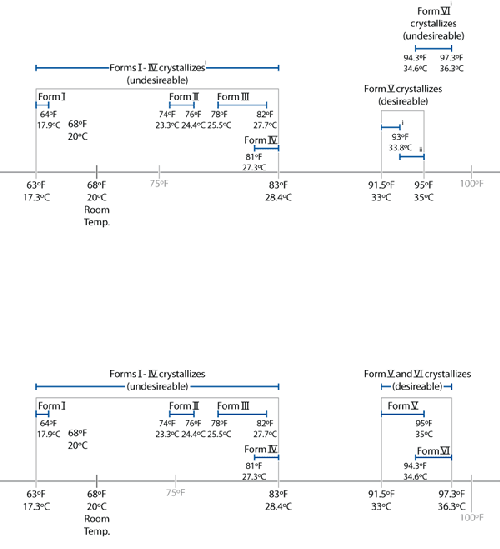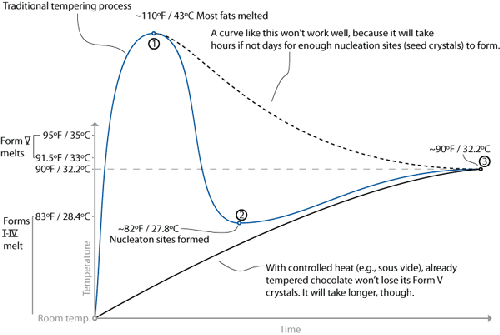3.6. Chocolate
Tempering chocolate—the process of selectively melting
and solidifying the various forms of fat crystals in cocoa butter—can be an intimidating
and finicky process. The chocolate must first be melted to above 110°F / 43°C, then
cooled to around 82°F / 28°C, and then heated back up and held between 89°F / 31.5°C and
91°F / 32.5°C. Once tempered, you must play a thermal balancing act: too warm, you lose
the temper, and too cold, it sets.
It’s not exactly correct to describe chocolate as something that “melts,” because
chocolate is a solid sol, a colloid of two different solids: cocoa powder and cocoa
fats. The cocoa powder itself can’t melt, but the cocoa fats that surround it can. Cocoa
butter contains six different forms of fats, and each form melts at a slightly different
temperature.
The six forms of cocoa fat are actually six different crystalline structures of the
same type of fat. Once melted, the fat can recrystallize into any of the six forms. It’s
for this reason that tempering works at all—essentially, tempering is all about coercing
the fats to solidify into the desired forms.
Melting points of the six polymorphs of cocoa fat.

Note:
How do scientists tell when something is melting? Two common techniques are used:
differential scanning calorimetry (DSC) and x-ray diffraction. In DSC, energy is added
to a closed system at a controlled rate, and the temperature of the system is
monitored. DSC picks up phase changes (e.g., solid to liquid) because phase changes
require energy without a temperature change. X-ray diffraction looks at how x-rays
scatter when passed through a sample: with each phase change, the x-ray pattern
changes.
It’s not a matter of different types
of fats; it’s the structure that the fat takes upon solidifying that determines its
form. Two of these forms (Forms V and VI) link together to create a metastructure that
gives chocolate a pleasing smoothness and firm snap when broken. Chocolate with a high
number of Form V structures is said to be tempered. The other
primary forms (I–IV) lead to a chalky, powdery texture. Form VI occurs in only small
quantities, due to the temperature range at which it crystalizes. Chocolate that has
been exposed to extreme temperature swings will slowly convert to Forms I–IV. Such
chocolate is described as having bloomed—the cocoa particles and
cocoa fats separate, giving the chocolate both a splotchy appearance and a gritty
texture.
To further complicate things, the fats in cocoa butters don’t actually melt at an
exact temperature, and the composition of the fats varies between batches. The ratio of
the different fats determines their exact melting point, and the ratio varies depending
upon the growing conditions of the cocoa plant. The fat in chocolate from beans grown at
lower elevations, for example, has a slightly higher melting point than chocolate from
beans grown at higher, cooler elevations.
Still, the temperature variances are relatively narrow, so the ranges used here
generally work for dark chocolates. Milk chocolates require slightly cooler
temperatures, because the additional ingredients affect the melting points of the
different crystalline forms. When looking at chocolate for tempering, make sure it does
not have other fats or lecithin added, because these ingredients affect the melting
point.
Luckily for chocolate lovers worldwide, chocolate has two quirks that make it so
enjoyable. For one, the undesirable forms of fat all melt below 90°F / 32°C, while the
desirable forms noticeably melt around 94°F / 34.4°C. If you heat the chocolate to a
temperature between these two points, the undesirable forms melt and then solidify into
the desirable form.
The second happy quirk is a matter of simple biology: the temperature of the inside
of your mouth is in the range of 95–98.6°F / 35–37°C, just above the melting point of
tempered chocolate, while the surface temperature of your hand is below this point.
Sure, a certain sugar-coated candy is known to be made to “melt in your mouth, not in
your hands,” but with properly tempered dark chocolate, the sugar coating isn’t
necessary (it is necessary for milk chocolate, though, which melts at a temperature
lower than that of your hand).
Note:
M&Ms were developed in 1940 by Frank C. Mars and his son, Forrest Mars, Sr.
During the Spanish Civil War (1936–1939), Forrest saw Spanish soldiers eating
chocolate that had been covered in sugar as a way of “packaging” the chocolate to
prevent it from making a mess.
How does all of this relate to sous vide cooking? Traditional tempering works by
melting all forms of fat in the chocolate, cooling it to a low enough temperature to
trigger nucleation formation (i.e., causing some of the fat to crystallize into seed
crystals, including some of the undesirable forms), and then raising it to a temperature
around 90°F / 32.2°C, where the fats crystallize to make Form V crystals.
This three-temperature process requires a watchful eye and, during the second step,
constant stirring to encourage the crystals to form while keeping them small. Water
baths allow for a shortcut in working with chocolate: already tempered chocolate doesn’t
need to be tempered if you don’t get it any hotter than around 91°F
/ 32.8°C. The desirable forms of fat won’t melt, so you’re good to go. To melt already
tempered chocolate, seal it in a vacuum bag and submerge it in a water bath set to 91°F
/ 32.8°C. (You can go a degree or so warmer; experiment!) Once it’s melted—which might
take an hour or so—remove the bag from the water, dry the outside, and snip off one
corner: instant piping bag.
Temperature versus time chart for melting and tempering
chocolate.

If you’re going to be
working with chocolate on a regular basis, the sous vide hack will probably get tiring.
It works, but if you have the dough to spend, search online for chocolate tempering
machines. One vendor, ChocoVision, sells units that combine a heat source, a motorized
stirrer, and a simple logic circuit that tempers and holds melted chocolate suitable for
everything from dipping fruit to coating pastries to filling chocolate molds. Of course,
if you have a slow cooker, thermocouple, and temperature controller...